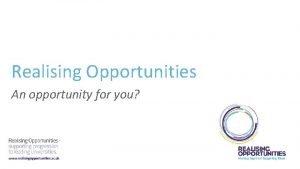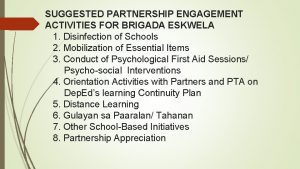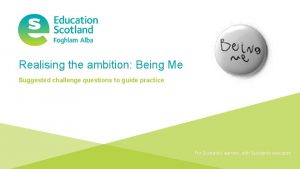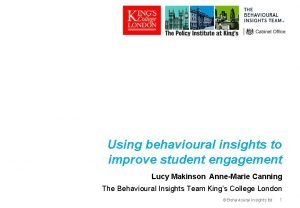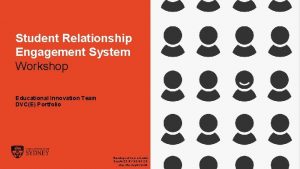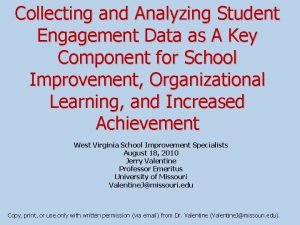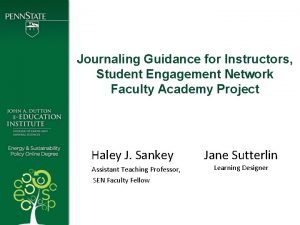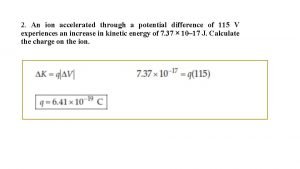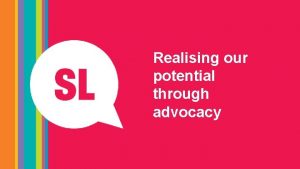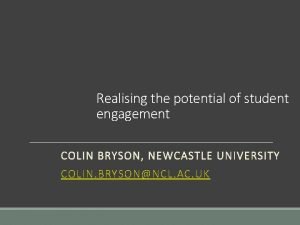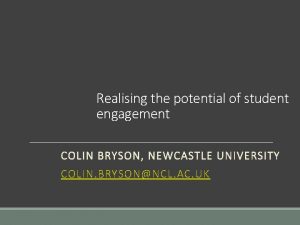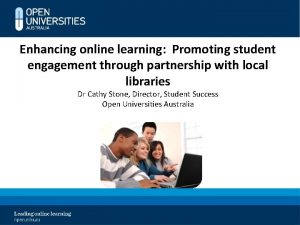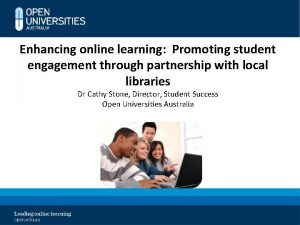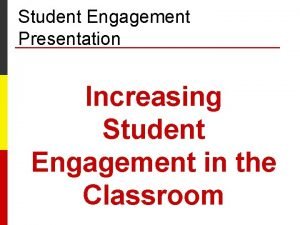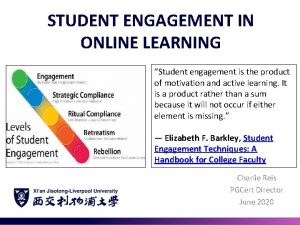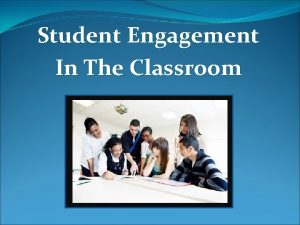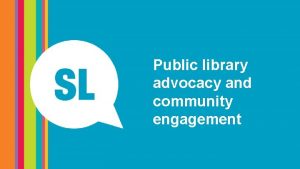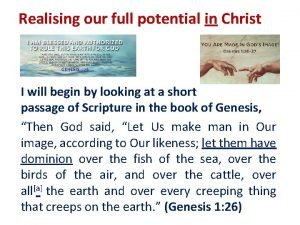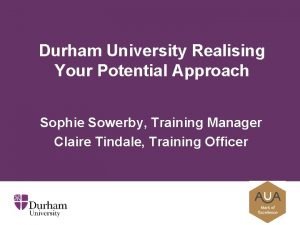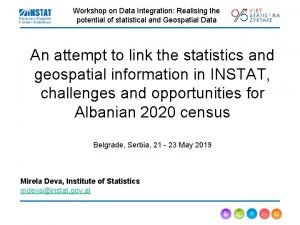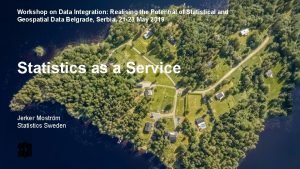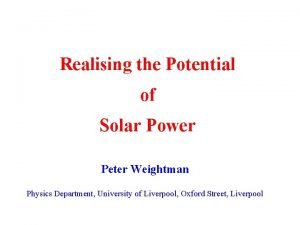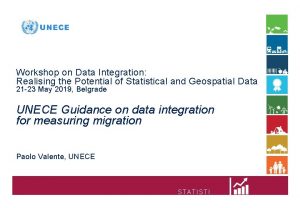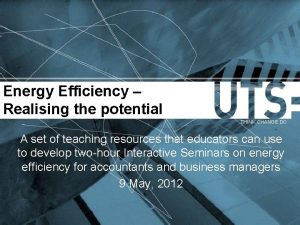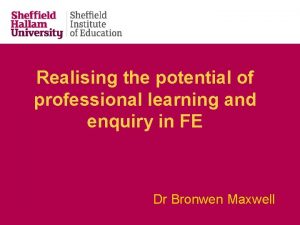Realising the potential of student engagement through partnership

































- Slides: 33

Realising the potential of student engagement through partnership. . COLIN BRYS ON AND JESS BELCH COLIN. BRYS ON@NCL. AC. UK J. BELC H@ NCL. AC. UK ANGLIARUSKIN 2017

The nature of student engagement Holistic and socially constructed ØEvery student is an individual and different (Haggis, 2004) ØEngagement is a concept which encompasses the perceptions, expectations and experience of being a student and the construction of being a student in HE (Bryson and Hand, 2007). ØEngagement underpins learning and is the glue that binds it together – both located in being and becoming. (Fromm, 1977) ØPowerful and deep learning requires strong engagement q. Salience of transformative learning q. Becoming – self-authorship (Baxter Magolda), self efficacy (Tinto), critical being (Barnett), graduate identity (Holmes) ANGLIARUSKIN 2017

q To involve and work with students in partnership q To establish an annual conference drawing together leading edge work on SE - and to feed into publication through journals and books. To create a bank of useful resources for us to share. q To disseminate good ideas and practice via our journal and other methods – Student Engagement in Higher Education Journal q Develop and support themes and interests through SIGS q To facilitate communication between us (web, email network etc) http: //www. raise-network. com ANGLIARUSKIN 2017

Why partnership? ØGrew out of our holistic student engagement strategy (Bryson, 2014; Furlonger et al, 2014) ØResonates with student engagement and seeking transformative learning ØRoots in critical and radical pedagogy ØCounter to neo-liberalism and the model of students as consumer (A Manifesto for Partnership, NUS, 2012; Neary; Mc. Cullough) ANGLIARUSKIN 2017

The virtues of partnership Epitomises positive values in society ØEthical ØDemocratic ØEnables Higher Education to a make a more profound contribution to society ØEducation should be exemplary but also dynamic, be progressive and ‘public’ ANGLIARUSKIN 2017

Cook-Sather, Bovill and Felten (2014: 6) We define student-faculty partnership as a collaborative, reciprocal process through which all participants have the opportunity to contribute equally, though not necessarily in the same ways, to curriculum or pedagogical conceptualisation, decision making, implementation, investigation or analysis ANGLIARUSKIN 2017

The ethos of partnership Principles of respect, repricocity and responsibility (Cook Sather et al, 2014) The participant must perceive (Bryson, Furlonger and Rinaldo, 2015): §That their participation and contribution is valued and valuable; §A sense of co-ownership, inclusion, and equalising of power relations between students and staff; §A sense of democracy, with an emphasis on participative democracy; §Membership of a community related to learning and educational context And this needs to be realised in practice – a virtuous circle ANGLIARUSKIN 2017

What is partnership? ANGLIARUSKIN 2017

A typology of Sa. P roles (Cook-Sather et al, Healey et al, 2014) ØConsultant to staff ØCo-designing ØCo-researching ØChange-agent (Dunne and Zandstra, 2011) ØPeer leading Focussed on So. TL, curriculum, QA/QE, subject based http: //www. mickhealey. co. uk/resources look under ‘change agents’ ANGLIARUSKIN 2017

Benefits of partnership (Cook-Sather, Bovill and Felten, 2014) Enhances (for both students AND staff) ØEngagement (motivation, in the learning process itself, sense of responsibility, recognition) ØMetacognitive awareness and identity ØActual L&T and classroom experiences ANGLIARUSKIN 2017

Institutional examples ØThe Teaching and Learning Academy (http: //library. wwu. edu/tla ) ØSALTs and similar schemes (Brynmawr, Winchester, BCU, Exeter, UCL) ØLincoln – a comprehensive approach So what are examples here? ANGLIARUSKIN 2017

Seeking to embed partnership Combined Honours at Newcastle ØDiverse and complex ØIndividuals doing unique degree ØMissing sense of identity/ belonging ØBut few resources and so difficult to influence the existing curriculum ANGLIARUSKIN 2017

The power of partnership- A students view ANGLIARUSKIN 2017

Who am I? • Jess Belch • Combined Honors student in History and Politics Stage 2 • Student Representative in Stage 1 for the Student Staff Committee • Current Chair of the SSC 2017/18 • Member of the Combined Honors Committee as Female Sports Sec 2017/18 I really see the value in student/staff partnership and have opted to take 1 Combined Module in Graduate Development to enhance graduate attributes and skills through a specially designed curriculum ANGLIARUSKIN 2017

Why is student engagement so important? Motivation Enriched learning experience Empowerment Emotional development ? Making connections “Engaged students are more likely to perform well… and contribute to a safe, positive and creative school climate and culture” (H, Marks 2000) ANGLIARUSKIN 2017

Student Voice in Combined Honours Broad range of opportunities provided to Combined Honours students: Peer Welfare Ambassadors PASS Combined Honours Society Student Staff Committee ANGLIARUSKIN 2017 Peer Mentor Scheme

The Student Staff Committee • An empowered SSC • A Chair/ Secretary • Stage representatives from Stage 1 to Stage 4 • 6 annual meetings to discuss agenda’s brought forward by a diverse cohort The SSC has been the driving force of many major structural decisions made in the CH program; from the creation of new modules to our peer mentor system. ANGLIARUSKIN 2017

My student voice experience in Combined ANGLIARUSKIN 2017

SSC Chair 2017/18 Possible agenda items as a Committee: • A couple of year group forums to network each semester • Reform methods of communication to our constituents • One Facebook utility page for all Combined Honours services and utilities • Open up more roles and opportunities for 1 st year students • A scheme to best support students about to prepare for their year abroad • A better network to support international students arriving in the UK ANGLIARUSKIN 2017

Issues and challenges Are there any? ANGLIARUSKIN 2017

Challenges to the standard mode and ways forward ØGetting started! ØResources? ØGetting staff colleagues on board… ØWill the students take part? ØVulnerability and risk to students and staff ØAvoiding pseudo-partnership ANGLIARUSKIN 2017

More challenges ØKeeping it fresh, exciting and radical ØWill students be too radical? Can I say no? ØLack of inclusivity - opportunities for few and not all ØSelective investment thus a bit elitist? ØBehaving ethically and fairly – phronesis (Taylor and Robinson, 2014) ØReward –wrong incentive (transactional) vs no incentive (exploitative) ØStudent representation - misfit with this model? ANGLIARUSKIN 2017

Selective partnership ØIndividualised relationships between student: staff ØGreat benefits for the students who do get involved but perhaps less so for others…. . ANGLIARUSKIN 2017

Reflections on our approach ØInvolves around 80 students in roles per year –over 15% ØWider opportunities for involvement – co-researching and internships, presenting at conferences, new ideas PICNIC – short term student exchanges ØOutcomes very strong – massive improvement in quality of student experience – students and schemes win awards; strong evidence (cohort surveys etc) –satisfaction in the NSS (average 97% over last five years); recruitment growth ØBut, how do we involve more students more directly? So they all gain the benefits…. . ANGLIARUSKIN 2017

Bringing in Universal Partnership ØA partnership ethos and culture FOR ALL STUDENTS ØCollective and inclusive ØThe curriculum offers ‘whole class’ participation Requiring ØCo-ownership of the agenda and process ØDemocratically agreeing important dimensions ØBuilding student: student (as well as staff: student) ØEnsuring all gain benefits and all ‘feel’ like a partner ØChanging identities – LEARNING COLLEAGUES ANGLIARUSKIN 2017

Co-design of curriculum 3 modes of student involvement 1. (Experienced) students (re)design a module 2. Students designing the module as it proceeds. 3. Students design a future module that they will do ANGLIARUSKIN 2017

Partnership within modules Ø 7 modules across all stages of degree ØDoing as much as possible in partnership, includes co-deciding: ◦ Shape and delivery (in part) of the module ◦ Students choose own projects/topics and thus drive content ◦ The types of assessment, weighting and deadlines ◦ Criteria (and thus learning outcomes) and ‘standards’ ANGLIARUSKIN 2017

Issues for the universal/curriculum model ØStudents sign up for the module and not necessarily partnership ØSome don’t like partnership–– a sense of frustration as ‘too much risk’ and unwanted responsibility that did not chime with their aims ØMore challenging for students at earlier degree stage? BUT scarier later on? ØTension between democratic principles vs ethics; collective v individual ØModule feedback is sometimes interesting! ANGLIARUSKIN 2017

Feedback (in Lea, 2015: 170) I can honestly say, one of most stressful, confusing and alienating experiences I have ever undertaken. But by far the most rewarding… I understood more and grew far more than at any other point in my university career, and it completely opened up my other courses as I started to look at them from a far broader standpoint and see the possibilities each held Sam Louis ANGLIARUSKIN 2017

Operational issues… ØSharing power effectively ØEnabling the quieter voices to be heard ØSafe spaces…. Ø‘Foregrounding’ assessment ANGLIARUSKIN 2017

Taking it further in CH ØRolling out further a more universal mode and creating partnership communities ØIncreasing our schemes (variety and nos. ) ØEnhancing the work of the SSC Developing a new type of curriculum and pedagogy ØFrom first year to final year through patchwork/portfolio assessment as learning, working collaboratively with students developing ongoing projects at their own pace. Staff being facilitators and colearners rather than judges (Mann, 2001) ANGLIARUSKIN 2017

Final advice – context is important ØStart small, in the spaces that you can find ØStart early in the student journey ØBe patient ØForm alliances ØDon’t coerce or rush in – induct and nurture (staff too!) ØBe conscious of your behaviour and how it is perceived ØSeek advice and listen to it ØLearn from mistakes ANGLIARUSKIN 2017

Conclusions ØPartnership works and enables strong SE and transformative learning in a mass HE system and offers much – has rejuvenated me! ØWorking and thinking outside comfort zones, but not too far outside… ØA mixed model legitimated by student representation mechanisms ANGLIARUSKIN 2017
 Realising opportunities student
Realising opportunities student Partnership engagement activities
Partnership engagement activities Partner engagement model
Partner engagement model Being me realising the ambition
Being me realising the ambition Student engagement insight
Student engagement insight Sres student portal
Sres student portal Australasian survey of student engagement
Australasian survey of student engagement Student engagement data collection
Student engagement data collection Student engagement presentation
Student engagement presentation Student engagement network
Student engagement network Osmotic potential vs water potential
Osmotic potential vs water potential How does water potential affect osmosis
How does water potential affect osmosis Water potential
Water potential Graded potential vs action potential
Graded potential vs action potential Decremental graded potential
Decremental graded potential Graded potential
Graded potential Graded vs action potential
Graded vs action potential Graded potential vs action potential
Graded potential vs action potential Osmotic potential vs water potential
Osmotic potential vs water potential Source of bioelectric potential
Source of bioelectric potential Hypopolarization
Hypopolarization Succinylcholine dose
Succinylcholine dose Axon hillock
Axon hillock Action potential resting potential
Action potential resting potential Sales potential vs market potential
Sales potential vs market potential Define electric potential and potential difference.
Define electric potential and potential difference. Potential unit
Potential unit Electric potential and potential difference
Electric potential and potential difference Potential difference si unit
Potential difference si unit Electrical potential energy
Electrical potential energy Joules to newtons
Joules to newtons Electric potential
Electric potential An ion accelerated through a potential difference of
An ion accelerated through a potential difference of Through one man sin entered the world, and through one man
Through one man sin entered the world, and through one man
